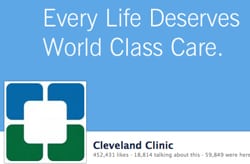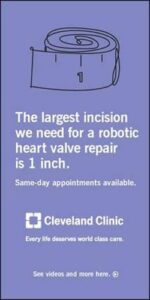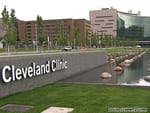Despite the fact that US News & World Report had ranked the Cleveland Clinic No. 1 in heart care for the past 18 years and the No. 4 hospital in America, on a national level its brand awareness had been flat and it trailed far behind its two major competitors. On a local level, the clinic had a reputation as a place royalty, but not for the everyday Cleveland resident.
“Brand awareness is the biggest issue we’ve had to address in the past six months,” Cynthia Galbincea, executive director, marketing communications at the clinic, said. “Our objective is to build brand recognition and have the top-of-mind recognition that MasterCard and Pepsi both have.”
Galbincea shared how the clinic employed an aggressive content strategy through paid, owned and earned media combined with organizational changes over the past six months to make huge strides in increasing ad awareness, patient appointments, website visits and Facebook fans. She spoke last month during the ANA Brand Masters Conference.
“Healthcare is a very low saliency topic unless you’re affected by it,” she said.
One of the most fortuitous circumstances came during the last presidential election cycle in the fight for Ohio. Both President Obama and Governor Mitt Romney made positive mention of the clinic’s care and lower costs in their first presidential debate in October 2012, a huge boost for the Cleveland Clinic’s marketing team.
It’s a lesson in striking while the iron is hot, having your organization set up to be nimble and quick, to jump on opportunities when they arise, Galbincea said. We all remember how Oreo took advantage of the 34-minute blackout during the 2013 Super Bowl when it tweeted to its fans, “You can still dunk in the dark.”
“Sixty-seven million Americans heard Obama in the first presidential debate call us one of the best,” she said. “The state of Ohio was really in play at that point as a very strategic win for either candidate. Our brand awareness reached an all time high.”
Within 48 hours of the presidential candidates’ comments the Cleveland Clinic ran ads to that affect in the New York Times, Wall Street Journal, USA Today and local and regional pubs. Broadcast media outlets also mentioned the comments.

“It generated 12 million impressions,” Galbincea said.
And the clinic, which runs eight community hospitals, 16 family health centers and employs 44,0000, posted about it on its Facebook page.
“To our slight surprise what we got back were hundreds of comments from grateful patients,” she said. “We couldn’t have asked for more engagement, it was unsolicited and rich engagement.”
Another major change that helped the clinic gain awareness was its work to encourage people to travel to the clinic. Locally it has 100% brand awareness but it found that people didn’t view it as accessible or approachable.
“People thought of it as a place for kings and sheiks, but not for every man or woman in Cleveland,” she said.
To address that public perception, the clinic made a major operational change to offer same-day appointments for people to be treated for anything and it marketed that message heavily.
“That has been extremely powerful,” Galbincea said. “We had more than 1 million appointments in 15 months since we began offering it.”
In Northeast Ohio it began running TV spots, including locally on the Super Bowl this year, featuring caregivers telling stories in their own words.
“We received 20,000 calls and made 12,348 same day appointments with thousands of others over the next days and weeks with 30% new clients to the clinic,” she said.
“Ad awareness was up 38% and our approachable attribute was up 16%.”
The clinic also put a focus on patient compassion and empathy. It held training and developed a video for internal purposes that it eventually posted on Facebook. It tweeted about the video and got 385,000 views within a few weeks.

Still going strong is its “unadorned facts” campaign underway for about five years targeting people likely to consider traveling for healthcare. It moved from the typical healthcare ads showing patients in an examination room talking to doctors in white coats to an architecture with vibrant colors, minimal modern graphics and unadorned direct facts distinct to the Cleveland Clinic like, “We regrow bone. Yes, you read that right.” with a graphic of hand and forearm seeming to grow from a plant stalk.
In speaking again of the Obama and Romney comments that really jumpstarted the clinic’s drive to improve brand awareness, Galbincea said, “This somewhat fortuitous opportunity has led us to a very good place, the visits to my.clevelandclinic.org are up 15% to 4 million per month. We’ve had 131% growth in Facebook fans and 71 million national ad impressions.”




